At this point you
might be wondering about the purpose of all this. Why switch an
electromagnet just so it can control another switch? Why not just use one
regular switch? One important application is illustrated in the diagram
below.
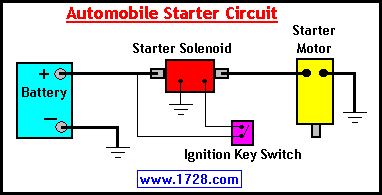 NOTE: the
NOTE: the  symbol
indicates a ground connection. Since a great percentage of an automobile
consists of metal, using the automobile itself as one "side" of a circuit
saves a tremendous amount of wire. symbol
indicates a ground connection. Since a great percentage of an automobile
consists of metal, using the automobile itself as one "side" of a circuit
saves a tremendous amount of wire.
When the ignition key is turned
all the way to the "start" position, it allows electricity to flow to the
starter solenoid (relay) which then connects the battery to the starter
motor. So why do we need this solenoid "middle man" ? Couldn't we just
eliminate it and connect the ignition wires to the + battery terminal and
the other wire to the starter motor?
The important point here is that the electromagnet
is using a small amount of current to control a
large amount of current to the starter motor. (Remember that the electromagnet
and the switch are NOT connected electrically).
Have you noticed that all of
the wires (except the ignition wires) are purposely drawn with thick lines?
The reason being that some circuits (such as the starter) in a car require a
tremendous amount of current. (If you look at an automobile's battery cables,
you will notice they are quite thick.) Connecting the ignition
wires to the battery and then to the starter motor would cause these thin
wires to
conduct much more current than they were designed for. These wires would
become
very hot and the insulation would start to smoke. (The same would hold true
for the ignition switch).
After starting the car for just
a few times, the wires and the switch would be in bad shape.
We do have a second choice. We could use
thick battery cables for the ignition wires and use a heavy duty ignition
switch. This isn't very practical either. Do you think it would be easy
to squeeze cables into the steering column and to squeeze in a heavy
duty ignition switch too? Therefore, the use of a solenoid is the most practical
solution.
*****************************************
For the next circuits, we recommend using a 9 volt battery, a 9 volt
electronic siren (or buzzer) and a 9 volt SPDT relay.
*****************************************
Another practical use of relays is for
switching one circuit 'on' when another circuit has been switched 'off'
or broken. What possible application requires such an odd switching
arrangement? How about a burglar alarm?
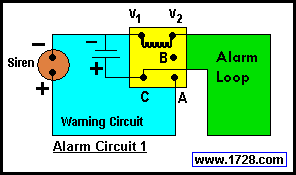
Referring to the above diagram, let's trace
the electrical flow. Since the alarm loop wire connects points 'V2' to 'C',
it can easily be seen that electricity flows from the negative battery
terminal, goes to V1 then V2, then (because the alarm loop is unbroken) it
goes to C and finally to the positive battery terminal. In this circuit,
current is flowing through the electromagnet, causing the SPDT
switch to make contact with terminal B. Because of this, the siren does
NOT sound because there is NO current going to point A.
Now let's suppose that the alarm loop is
broken. The wire does not necessarily have to be cut
to trigger the alarm. Perhaps one or more magnetic switches could be wired
in series in the alarm loop and when one magnet moves, it causes the switch
contact to break and then the alarm will sound. The electricity is now
flowing across points C and A to the siren and NOT the electromagnet.
Alarm Circuit 1 does suffer from one serious
flaw. Can you see what it is? If the alarm loop is reconnected, the siren
shuts off. This is NOT recommended for any serious alarm system. After all,
if a door with a magnetic switch is forced open, all a burglar would have to
do is close the door. The siren then goes off ! Is there a better way to
wire an alarm? Sure.
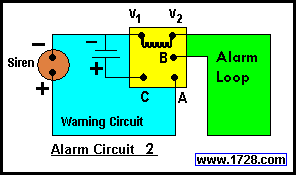
Alarm Circuit 2 looks very similar to Circuit
1, the only difference being that one side of the alarm loop now goes to
point B instead of point C. What happens when current is applied to this
circuit? The siren sounds off immediately and stays on continuously.
Hmmm, that sure seems like an annoying alarm circuit. (Did Tim Conway's
father wire it? If you don't get this joke, see Part I).
Now for the 'beauty' of this clever circuit.
By using a scrap of wire, temporarily connect point B to point C. The
alarm shuts off immediately. If you break the alarm loop, the siren sounds
once again. What happens if the alarm loop is reconnected? The siren still
blasts away. Now that's a much better alarm circuit! Let's see how
it works. Temporarily connecting points B and C causes current to flow
through the electromagnet, which attracts the switch to point B. As long
as the alarm loop remains unbroken the alarm remains silent. Break the
alarm loop, the alarm sounds. Unlike Circuit 1, reconnecting the alarm
loop no longer causes current to flow through the electromagnet. The
only way to activate the electromagnet is by connecting points B and
C. All right!
In the 'real world', the relay, the power
supply (battery) and the siren should be inaccessible to everyone except
those authorized to 'arm' and 'disarm' it. You can easily see that the
alarm could be 'sabotaged' in a number of ways if unauthorized persons
had access to it. Incidentally, this type of circuit is called a
supervised alarm system. Why?
If the alarm loop were to be broken, you would never be able to arm it.
Therefore, in a real world application, if the alarm cannot be armed, you
would know something was wrong (a door might be open, a wire might be
broken, etc.). Also, in real world applications, an alarm would be much more
complex than the one shown here. The arming process would probably be done
with a key switch.
The alarm might also have flashing lights, an
automatic phone dialer to the police and so on. The
circuits shown are for demonstration and educational purposes only and NOT
meant to be used in place of professional alarm systems.
One more circuit should be shown because in
real life, the same power supply probably would not operate the
alarm loop as well as the warning circuit. The diagram for such an
arrangement is shown below in Alarm Circuit 3.
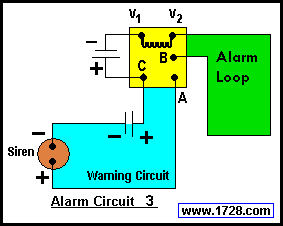
As far as building a
science project, we
would recommend Alarm Circuit 2, which probably could be built for about $5.
(Yes, you could add some magnetic switches to the alarm loop but remember
this will increase the cost very quickly). Though inexpensive and
consisting of only 3 parts, Circuit 2 demonstrates some
important electrical concepts. By all means, do some further research on
relays, alarms and so on.
And good luck with the project !!!
*****************************************
Just a few more words about relays. As is the
case with many mechanical devices being replaced by their electronic
equivalents, relays are being "phased out" by Solid State Relays (SSR's).
Mechanical relays
do have their disadvantages when compared to
an SSR:
1) switching is much slower
2) the contacts wear out
3) they make noise when they switch
4) their magnetic fields can cause problems for nearby
components
Presently, their one advantage is their ability to
switch high voltage and high current circuits. (the automobile starter solenoid for example).
No doubt with time, even this
will be surpassed by the SSR. At least mechanical relays can
easily demonstrate the principles of electrical/electronic switching.
|
 IMPORTANT !!! DO NOT use wall current !!!
IMPORTANT !!! DO NOT use wall current !!!

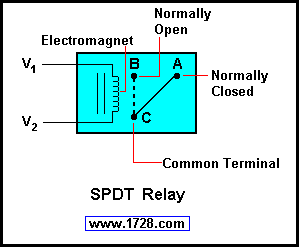
 IMPORTANT !!! DO NOT use wall current !!!
IMPORTANT !!! DO NOT use wall current !!!

